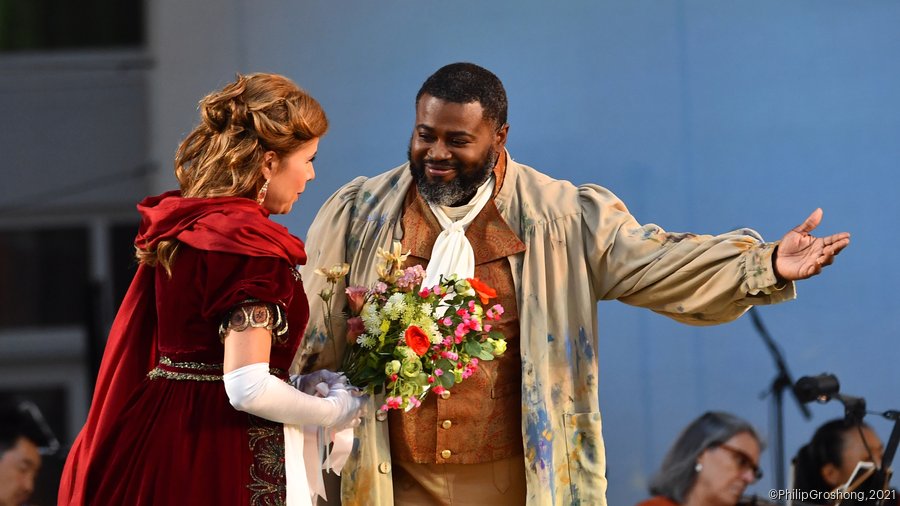Cincinnati Opera’s “Tosca” was a triumph of singing on Friday in its opening performance at Summit Park in Blue Ash. But one rapturous moment stood still amid all of the high-octane emotion and political drama of Puccini’s tragedy.
Just before summoning the courage to stab to death the lecherous police chief Scarpia, Ana María Martínez, as the diva Floria Tosca, sang a heartbreaking prayer. Her “Vissi d’arte,” in which she asks God why she is being made to suffer, was breathtaking. Turning to the statue of the Virgin Mary (that conveniently remained onstage for the whole opera), the soprano phrased with lyrical beauty and communicated her vunerablity as well as the strength that would carry her forward.
This was an evening where everything came together magnificently. That was no small feat, considering the challenges of mounting opera outdoors on a newly constructed stage, with amplified singers and musicians, limited sets and a score trimmed down to 90 minutes.
And what a riveting 90 minutes. Not only was the opera gloriously sung, but it was wonderfully conducted by Xian Zhang, who led with dramatic urgency and made the 40 members of the Cincinnati Symphony Orchestra sound as lush as could be.
Making her Cincinnati Opera debut -- and in her first fully staged performance of this role -- Martínez mesmerized as the diva who tries to save her lover from death. Making her entrance, she swept regally onto the stage, conveying the purity of her love in the opening scene with her lover, Cavaradossi. Later, the confusion, hurt and anger of his supposed betrayal was palpable.
As she was finally driven to her act of desperation, she stabbed Scarpia over and over. Through it all, she sang with beauty of line and stunning top notes. Later, describing to Cavaradossi the horror of plunging her knife into Scarpia’s heart, her high notes were searing.
Her artistry was perfectly matched by tenor Russell Thomas, as the painter and political activist Cavaradossi. We knew we were in for a treat the moment he unleashed his exciting, ardent tenor in the first act’s “Recondita armonia.” His love duet with Martínez was affectionate and utterly believable, as their smiles to each other could easily be seen on the big screens flanking the stage.
The opera takes place in 1800 in Rome, when Napolean is viewed as the ideal of freedom, the one who will defeat the tyranny in Rome. In the second act, when word arrived that Napolean had won a victory, Thomas’ cry of “Victory!” rang out powerfully across the vast Great Lawn of the park. The last act’s “E lucevan le stelle” was an emotional tour de force.
The character of the evil police chief Scarpia is often played as brutal or crude. However, the portrayal by Hawaiian baritone Quinn Kelsey – also in his first staged performance of the role -- had much more subtlety. He was a smooth villian, one who seduced his victims with a voice of velvet – while putting an arm around Cavaradossi’s shoulder before sending him to be tortured or pulling up a chair for Tosca to sit. His voice could be warmly lyrical, as it was in the second act, as he sang, “I prefer violent conquests.” Consumed with desire, his malevalence was always just beneath the surface, and evil laugh was perfectly timed.
In smaller roles, Samuel Smith was a fine Sacristan. Phillip Bullock performed well in his much-abbreviated role as the escaped political prisoner Angelotti.
On the orchestra podium behind the singers, Zhang matched every breath and phrase, and propelled the drama masterfully. She painted Puccini’s canvas with a sure hand as she summoned rich textures and swept up the orchestra in powerful, surging climaxes. The first act “Te Deum,” with its organ, cannon shots, chimes and the chanting of Henri Venanzi’s chorus, was wonderfully atmospheric. Yet she also knew just where to linger to allow the music to breathe.
Staging by Jose Maria Condemi could not have been more seamless. The company made good use of minimal props. For instance, the table where Scarpia wrote his orders was overturned to become the execution wall for Cavaradossi. There were a few changes to tradition. Tosca did not place candles around Scarpia’s body or put a cruxifix on his chest. Neither did she jump off a parapet. Without giving it away, she took her life in a different manner.
“Tosca” repeats at 8:30 p.m. July 27 and 31 in Summit Park. No intermission. Tickets: 513-241-2742, cincinnatiopera.org.
Janelle Gelfand's work is supported by the Rubin Institute for Music Criticism, San Francisco Conservatory of Music, and Ann and Gordon Getty Foundation.
